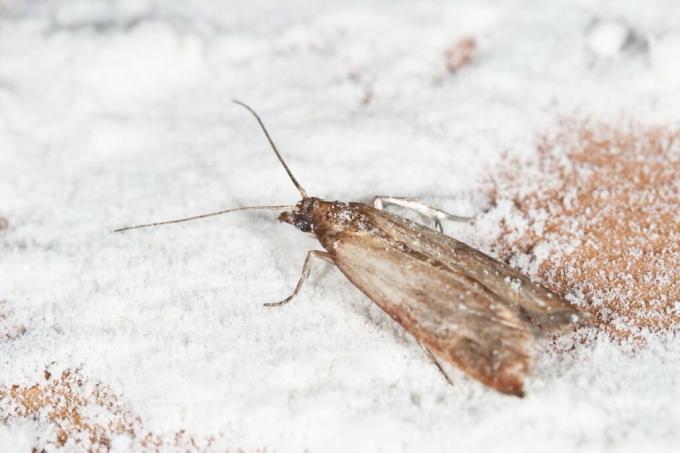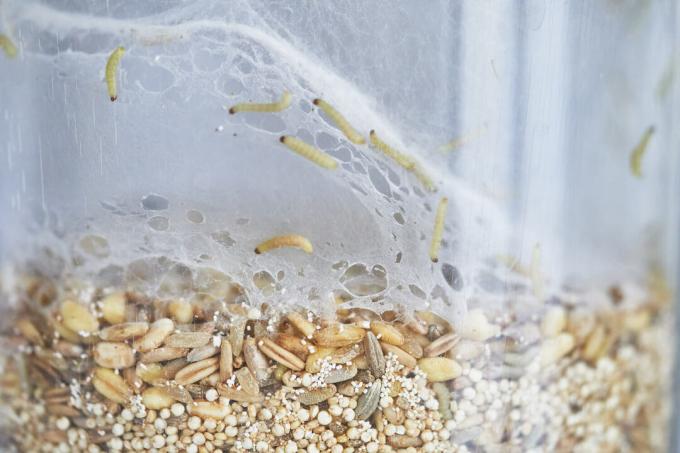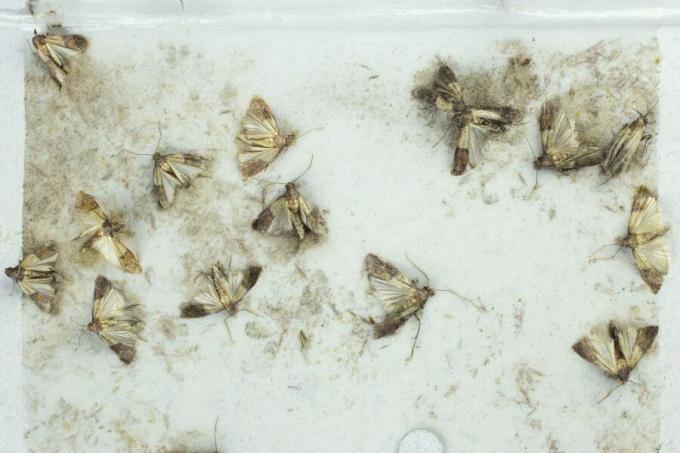How do you recognize the larvae, eggs and moths of flour moths? How can you prevent food moths? Our tips for fighting flour moths naturally.

Have you ever had the pleasure of finding small maggots or greyish moths in flour or other foods? As a rule, the appetite is gone afterwards and one asks oneself: where do these little animals come from? These are stored product pests and in many cases it is the flour moth (Ephestia kuehniella). In addition to dry grain products such as flour, pasta, rice or baked goods, dried fruit or mushrooms can also be used as food in exceptional cases. Once settled, the small pests can multiply excellently in a well-stocked pantry and are therefore often difficult to drive away again. How to recognize an infestation, successfully declare war on moths and your food in the future from the voracious little animals, you can find out here in our article on the subject flour moth.
contents
- Flour Moth: Wanted Poster
-
Identify flour moths
- Recognize adult flour moths
- Detect flour moth larvae
-
Fight flour moths naturally
- Fight flour moths with parasitic wasps
- Flour moth trap: Why traps are not a control method
- You should pay attention to this after a flour moth infestation
- Preventing flour moths: How to protect your food
Flour Moth: Wanted Poster
The flour moth moth (1 to 1.4 cm body length) is particularly active in summer and then especially at night. The eggs and larvae need as much heat as possible to develop. If you find them, there can be up to four generations per year. The larvae are often brought in via contaminated food, or the greyish moths flutter unnoticed when airing the house. When they find an accessible food source, it only takes about 96 hours for the laid egg to develop into a small, voracious larva. Incidentally, these are not maggots, the correct term is caterpillar or larva. However, female flour moths don't just lay a single egg - they can lay several hundred eggs in their short lives! Depending on the temperature, the larvae then eat for about 40 days in total until they have reached their final size. They then leave the food source, pupate, and within 9 days become an adult moth that begins laying eggs again.
Identify flour moths
Recognize adult flour moths
The appearance of the adult animals is not very spectacular, as you can see from the pictures. The moths are gray in color and have distinct patterns. However, this drawing is quite variable, which is why the appearance of the moths can always vary somewhat.
Moth traps are a simple tool for determining early and reliably whether flour moths have somehow gotten into the house. Pheromone traps like ours Plantura food moth traps contain attractants that are unique to the various types of food moths appear attractive. Male moths respond to these attractants and fly to their source, where they find a sticky slab for the moths to cling to. If you choose our Plantura food moth traps decide, you will be sent six of the odorless glue traps, which you can simply stick in all the cupboards and pantries concerned. After removing the protective film, the trap is activated and then attracts male food moths from the immediate vicinity for about six weeks.
Detect flour moth larvae
The actual damage to food comes from the larvae of the flour moth. After hatching, the initially small larvae measure less than 1 mm. The animals are then, just like the eggs of the meal moth, hardly recognizable to the human eye. So it is not unlikely that you have eaten one or the other small meal moth larvae in the course of your life. However, the butterfly larvae do not remain so small and reach a length of 1.3 cm when fully grown. Incidentally, during their development, the small caterpillars do not need a drop of water and can cover a distance of up to 400 meters. A real miracle of nature.
In addition to the larvae and of course their excrement, there are also webs in the infested food. During their evolution, the moths molt several times and spin threads along their route, causing flour and other foods to clump together. With dry, finely ground foods, you should always be suspicious if there are suddenly smaller or larger lumps in them. The webs are very problematic because they have the property of attracting condensation. The moisture can then cause mold to form or flour mites to be attracted. The flour moth larvae themselves are completely harmless and non-toxic. Nevertheless, very few people want an extra portion of protein in their grain products.

Summary of recognizing flour moths:
- Adult animals: 1 - 1.4 cm large moths with brown patterned wings
- Larvae: Maggot-like creatures up to 1.3 cm long
- Webs: Lumpy foods such as flour or cohesive grains
Fight flour moths naturally
Once you have discovered the small pests, you have to declare war on them. However, it is not advisable to use moth spray, which is perhaps an obvious choice. Because the chemical sprays contain toxic substances that you certainly do not want to use in your kitchen and near your food. We present natural and more sustainable alternatives in the following sections. Please note that infested food always poses a health risk as it spreads over the excrement of the larvae and their webs colonize toxic mold and other pests be able. Affected food must therefore be disposed of immediately.

Fight flour moths with parasitic wasps
The most natural and effective method of combating flour moths is biological pest control using predators. Certain parasitic wasps of the genus trichograma have specialized in the course of their development in the parasitization of moth eggs. Because of this special adaptation, they are a highly effective control method against moth pests and have been used since the 19th century. Bred and sold for this purpose for centuries.
Also for ours Plantura parasitic wasps against food moths we use a species of this genus, viz Trichogramma evanescens, which is a chemical-free and therefore human and environmentally friendly method of moth control. We deliver the little beneficial insects to you on cards of 2000 pieces each - still in their eggs and in different stages of development. Shortly after their arrival, the tiny creatures hatch and immediately get to work. They lay their own eggs inside the moth's eggs, rendering them harmless. In doing so, they are extremely discreet, since they can hardly be seen with the naked eye. Parasitic wasps also have no sting and are therefore completely harmless to your children or pets. You can find out more about this in our detailed Ichneumon wasp wanted poster.
Even if the parasitic wasps work hard, the application is very easy for you. Lay out the cards for 14 days in the affected area - be it a kitchen or the pantry. One card is enough for about one square meter, which is why we recommend four cards for a normal-sized kitchen. The application must then be repeated four times to guarantee the elimination of all subsequent generations and a definitive control of the pests. So that you always have fresh parasitic wasps at home at the right time, you will receive a new delivery of cards every two weeks. After eight weeks, you are moth-free again and the small parasitic wasps die unnoticed as soon as no new moth eggs are available.
Summary: Ichneumon wasps are so easy to use
- Order your Plantura Ichneumon wasps against food moths (the amount of cards depends on the size of your kitchen/pantry: one card covers one square meter).
- Lay out the cards in the affected area for 14 days.
- Every 14 days you will receive a free follow-up delivery of fresh parasitic wasps.
- Repeat the application for another 3 x 14 days.
Tip: After use, wipe the affected shelves thoroughly with a damp cloth to remove the remains of the beneficial parasitic wasps.
Flour moth trap: Why traps are not a control method
As described above, only male moths are attracted to pheromone traps. However, all it takes is one male escaping the trap and mating with a few females, who then lay up to 500 eggs each, to sustain the moth population. For this reason, moth traps are not suitable for fighting. Still, the use of pheromone traps, like ours Plantura food moth traps useful, namely to detect an infestation early and to determine the success during the fight. Since fighting with parasitic wasps, for example, takes at least eight weeks, but the traps take more than six weeks, they should be changed at least once during the treatment period will.
Tip: Even after that, you can leave a few traps in the cupboard to be on the safe side, so that you can identify a new infestation in good time and prevent major damage.

You should pay attention to this after a flour moth infestation
If foods such as cereal flour or pasta are contaminated by the flour moth, they should be disposed of to be on the safe side. Even if the animals themselves are non-toxic, a harmful mold could already have formed in the food. It is up to you whether all other less well-packaged foodstuffs are destroyed at the same time. You can also leave such food in the oven for at least 20 minutes at 60 °C, because the larvae will not survive that.
Cupboards or drawers with infested food should also be cleaned thoroughly and then wiped out with a vinegar-water mixture. The household remedy vinegar kills any remaining moth eggs. In the case of a severe infestation, however, vinegar is no longer enough, because the moth eggs are hardly visible to the naked eye and therefore difficult to remove completely. For this reason, parasitic wasps are the more thorough method. Incidentally, food is quite safe in the refrigerator because the caterpillars can only develop at temperatures above 10 °C.
Summary: What should you do if you have a flour moth infestation?
- Dispose of infested food immediately
- Heat the remaining food to 60 °C
- Highly effective, biological pest control using parasitic wasps
- Wash shelves with vinegar
- Use sticky traps only to control or detect infestation
Preventing flour moths: How to protect your food
It's actually quite simple: the flour moth must not get to the food. Then there is no problem with the larvae or any mold growth. But this is only half the truth.

Food packaging made of thin cardboard or thin foil is not an obstacle for the larvae. In these cases, the larva will simply dig a small hole to gain access to food. The hole can be so small that you won't even notice it. The cunning caterpillars can even get to the food of their desires via a closed screw cap. Only thicker plastic containers or jars that seal airtight offer reliable protection.
In addition to the flour moth, there are others food mothsthat can make your life difficult. Similar approaches apply to them as to the flour moth. And also the Control of clothes moths is possible with parasitic wasps.

